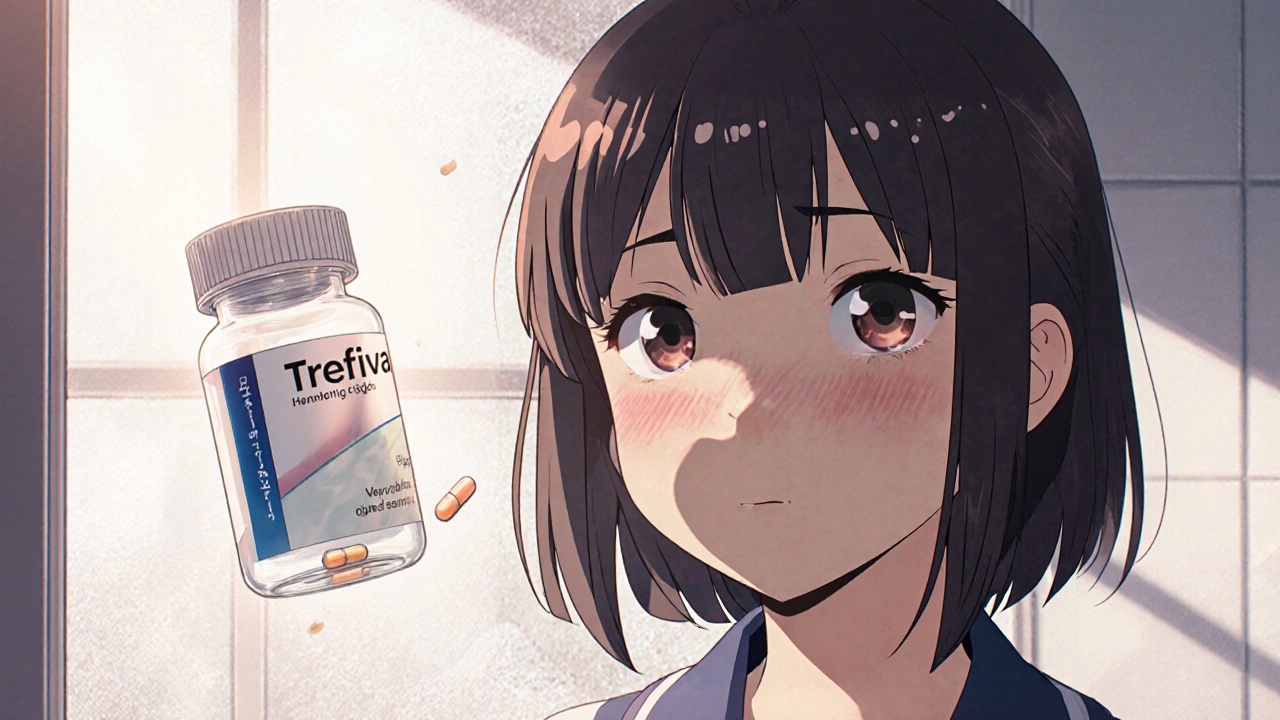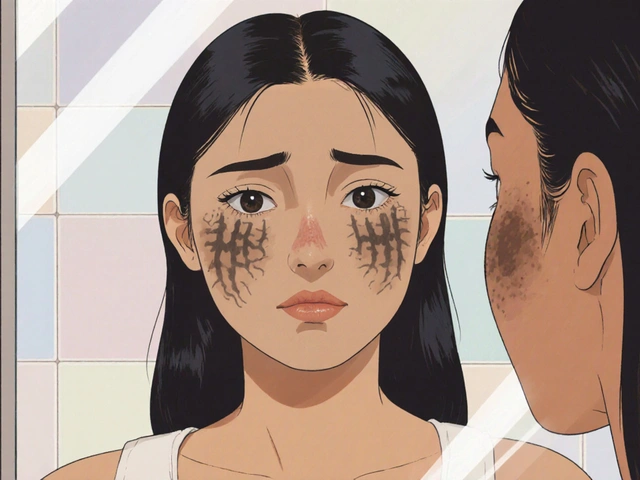Acne Treatment Selector Tool
Find Your Best Acne Treatment
This tool helps you determine which acne treatment option might be most appropriate for your specific situation based on acne severity, medical history, and lifestyle factors.
When battling severe cystic acne, many turn to Tretiva (Isotretinoin), a powerful oral retinoid that targets the root causes of breakouts. But is it the only game‑changer on the market? This guide pits Tretiva against the most‑common alternatives, so you can see which option fits your skin, lifestyle, and medical profile.
What Is Tretiva (Isotretinoin) Exactly?
Isotretinoin is a synthetic derivative of vitamin A. It works by shrinking the sebaceous glands, reducing oil production, and normalising skin cell turnover. Because it attacks the three main pillars of acne-excess oil, clogged pores, bacteria, and inflammation-doctors often reserve it for moderate‑to‑severe nodular acne that hasn’t responded to topical or oral antibiotics.
How Does Tretiva Work?
- Sebum suppression: Sebaceous gland size can shrink by up to 70%, slashing oil output.
- Cell turnover: Normalises keratinisation, preventing comedone formation.
- Anti‑inflammatory: Lowers inflammatory cytokines, calming active lesions.
The combination often yields dramatic clearing after a 4‑6 month course, with many patients staying breakout‑free for years.
Benefits of Choosing Tretiva
- High cure rate-studies show ~80% of patients achieve clear skin.
- One‑time course: Most regimens last 4‑6 months, after which the drug is stopped.
- Long‑term remission: Relapse rates drop dramatically compared to antibiotics.
Potential Drawbacks and Safety Concerns
Because isotretinoin reshapes the skin’s biology, it carries a notable side‑effect profile.
- Dry skin, lips, and eyes are almost universal.
- Elevated liver enzymes and triglycerides require regular blood monitoring.
- Teratogenic risk: pregnancy must be avoided for at least one month after stopping.
- Rare psychiatric effects-depression, mood swings-need close observation.
These concerns mean that a dermatologist will run baseline labs, schedule monthly checks, and enforce strict contraception for women of childbearing age.
Who Should Consider Tretiva?
Ideal candidates are patients with:
- Grade 3-4 nodular or cystic acne.
- Failure to improve after 3‑6 months of topical retinoids, benzoyl peroxide, or oral antibiotics.
- Clear willingness to adhere to lab monitoring and contraception requirements.
Alternative Acne Treatments Worth Considering
If the strict monitoring or side‑effects of isotretinoin feel daunting, several alternatives can deliver solid results without systemic risks. Below are the most frequently prescribed options.
Topical Retinoid: Adapalene
Adapalene is a third‑generation retinoid available over‑the‑counter in 0.1% strength. It unclogs pores and reduces inflammation, making it a solid first‑line for mild‑to‑moderate acne.
Oral Antibiotic: Doxycycline
Doxycycline suppresses Cutibacterium acnes bacteria and has anti‑inflammatory properties. Courses typically last 3‑4 months, often in combination with topical agents.
Hormonal Therapy: Spironolactone
Spironolactone blocks androgen receptors, lowering sebum output-especially useful for adult women with hormonal flare‑ups.
Fast‑Acting Topical: Benzoyl Peroxide
Works by oxidising bacterial membranes and drying out pores. Often paired with topical antibiotics to prevent resistance.
Procedural Option: Photodynamic Therapy (PDT)
PDT uses a photosensitising cream activated by a specific wavelength of light, cutting down on oil glands and bacteria in a single office visit.
Chemical Peels: Chemical Peeling
Alpha‑hydroxy acids (AHA) or beta‑hydroxy acids (BHA) exfoliate the skin, reducing comedones and improving texture.
Leave‑On Exfoliant: Salicylic Acid
Penetrates oily pores, dissolving sebum and debris. Ideal for oily or mixed‑type skin.
Side‑by‑Side Comparison
| Attribute | Tretiva (Isotretinoin) | Adapalene | Doxycycline | Spironolactone | Benzoyl Peroxide | PDT |
|---|---|---|---|---|---|---|
| Mechanism | Systemic retinoid - shrinks oil glands, normalises cell turnover | Topical retinoid - promotes desquamation | Antibiotic - kills C. acnes, anti‑inflammatory | Anti‑androgen - reduces sebum production | Oxidising agent - kills bacteria, dries pores | Photosensitiser + light - destroys sebaceous glands |
| Route | Oral | Topical | Oral | Oral | Topical | In‑office |
| Typical Duration | 4‑6 months (single course) | Continuous, 2‑3 months to see effect | 3‑4 months | 6‑12 months (as needed) | 2‑4 weeks for noticeable improvement | 1‑2 sessions |
| Efficacy (clearance %) | 70‑80% | 30‑45% | 30‑50% | 40‑60% (women) | 20‑30% | 50‑70% |
| Main Side Effects | Dryness, liver elevation, teratogenicity | Skin irritation, photosensitivity | GI upset, photosensitivity | Irregular periods, dizziness | Dryness, bleaching of fabrics | Redness, temporary swelling |
| Monitoring Needed | Liver enzymes, lipids, pregnancy test | None (except sunscreen) | None for short courses | Blood potassium, blood pressure | None | Pre‑treatment skin assessment |
| Best For | Severe nodular/cystic acne, refractory cases | Mild‑moderate acne, retinoid‑naïve | Inflammatory papules/pustules, quick control | Adult female hormonal acne | Comedonal acne, quick surface action | Patients wanting a short‑term office procedure |

How to Decide Which Path Is Right for You
Start with a clear assessment of acne severity, skin type, and lifestyle constraints.
- Severity check: If you have deep nodules, scarring, or have tried at least two other regimens without success, isotretinoin moves to the top of the list.
- Medical history: Liver disease, cholesterol issues, or pregnancy plans steer you away from Tretiva.
- Commitment level: Oral antibiotics and hormonal pills need daily adherence; topical retinoids need consistent night‑time application.
- Cost & insurance: Isotretinoin is often covered, but the lab work adds cost. PDT may be pricey per session.
- Side‑effect tolerance: If you can’t handle dry lips or frequent blood draws, start with milder options.
Consult a board‑certified dermatologist. They’ll weigh these factors, run baseline labs if needed, and tailor a regimen that fits your life.
Tips for Maximising Results, Whatever You Choose
- Always pair a retinoid (oral or topical) with a gentle moisturizer and sunscreen.
- For isotretinoin, schedule blood work before starting, then monthly for liver enzymes and triglycerides.
- When using oral antibiotics, avoid taking them with dairy or calcium‑rich foods, which reduce absorption.
- Hormonal therapy works best when combined with a consistent skin‑care routine and stress management.
- Procedural treatments need a pre‑procedure skin prep-avoid retinoids a week before PDT to reduce irritation.
Bottom Line
Tretiva (Isotretinoin) remains the gold standard for severe, stubborn acne, delivering the highest clearance rates ever recorded. However, its need for strict monitoring and its side‑effect profile mean it’s not the first choice for everyone. Alternatives-from gentle topical retinoids like Adapalene to hormonal blocks like Spironolactone-offer effective pathways with fewer systemic risks. By mapping your acne’s severity, health history, and willingness to commit, you can pick the treatment that clears skin while fitting your life.
Can I use Tretiva while pregnant?
No. Isotretinoin is highly teratogenic. Women must use two forms of contraception and have a negative pregnancy test before, during, and for at least one month after treatment.
How long does a typical Tretiva course last?
Most dermatologists prescribe 4 to 6 months, aiming for a cumulative dose of 120‑150 mg/kg over the entire course.
Is Adapalene strong enough for moderate acne?
Yes. For many with moderate papules and comedones, 0.1% Adapalene applied nightly can achieve clear skin within 8‑12 weeks, especially when paired with benzoyl peroxide.
Do I need blood tests for doxycycline?
Routine labs aren’t required for short courses, but if you have liver disease or are on other medications, a doctor may order baseline liver enzymes.
Can I combine Spironolactone with a topical retinoid?
Absolutely. Many dermatologists prescribe both to tackle hormonal excess and follicular hyper‑keratinisation simultaneously. Monitor potassium levels if using high doses.
What’s the recovery time after Photodynamic Therapy?
Redness and mild swelling subside within 24‑48 hours. Full results appear over 4‑6 weeks as the treated glands shrink.
Are chemical peels safe for someone on isotretinoin?
Not during active isotretinoin treatment. The skin is too fragile; wait at least six months after finishing isotretinoin before undergoing aggressive peels.






Jordan Levine
October 24, 2025 AT 18:36Listen up, folks! If you think isotretinoin is just another pill, you’re clueless 😡💥 This drug slashes oil like a war machine, and if you’re not ready to wage the battle, stay home! America’s skin deserves the strongest arsenal, not some weak tea‑time cream! 🚀
Carla Taylor
October 27, 2025 AT 02:09We all want clear skin and there are many paths you can take
Kathryn Rude
October 29, 2025 AT 04:09One must contemplate the ontological hierarchy of dermatologic interventions; isotretinoin occupies the apex of the pellucid spectrum of curative potency ; it is the Nietzschean will to power of the skin realm ; yet the masses flounder in mediocrity with mere benzoyl peroxide ;)
Jacqueline Galvan
October 31, 2025 AT 00:36Indeed, the pharmacodynamics of isotretinoin are superior in reducing sebaceous gland size, but clinicians must weigh hepatic monitoring and teratogenic safeguards. For patients contraindicated, topical retinoids such as adapalene offer a viable, lower‑risk alternative with acceptable efficacy. Continuous moisturization and sunscreen remain essential adjuncts regardless of modality.
Tammy Watkins
November 1, 2025 AT 15:29Determining the optimal acne regimen demands a comprehensive assessment of severity, comorbidities, and patient preferences.
Isotretinoin, with its systemic retinoid mechanism, remains unparalleled in achieving sustained remission for nodular cystic disease.
Nevertheless, its requirement for monthly laboratory surveillance and strict contraception protocols cannot be overlooked.
Patients with hepatic dysfunction or dyslipidemia should be counseled toward alternatives that lack systemic metabolic impact.
Topical retinoids, exemplified by adapalene, modulate follicular keratinisation with a favorable safety profile.
Oral doxycycline provides rapid anti‑inflammatory relief but carries risks of photosensitivity and gastrointestinal upset.
Hormonal modulation via spironolactone is particularly advantageous for adult women experiencing androgen‑driven flare‑ups.
Benzoyl peroxide offers a swift antibacterial action suitable for superficial comedonal lesions.
Photodynamic therapy delivers a procedural avenue that reduces sebaceous activity in one or two sessions.
Chemical exfoliation using AHA or BHA agents can improve texture but may exacerbate irritation when combined with isotretinoin.
The cost considerations, including medication, monitoring, and potential procedural fees, should be transparently discussed.
Insurance coverage often favors isotretinoin, yet out‑of‑pocket expenses for lab work may accumulate.
Ultimately, shared decision‑making empowers patients to commit to a regimen they can sustain.
Incorporating a gentle moisturizer and broad‑spectrum sunscreen mitigates the xerotic side‑effects common across therapies.
By aligning therapeutic potency with individual risk tolerance, clinicians can orchestrate a pathway to clearer skin and improved quality of life.
Dawn Bengel
November 3, 2025 AT 00:49Patriotically speaking, nothing beats a bold, all‑in isotretinoin course for the American dream of flawless skin 🇺🇸💪 If you’re scared of a few blood draws, you’re just cowering behind weak excuses! #USA #SkinWarrior
junior garcia
November 4, 2025 AT 04:36Your skin’s story matters, keep fighting.
Dason Avery
November 5, 2025 AT 02:49Every blemish is a reminder that we are evolving; embracing change transforms acne into wisdom 🌱✨ Trust the process and let resilience shine.
Casey Morris
November 5, 2025 AT 19:29It is, without a shred of doubt, incumbent upon the discerning clinician to meticulously juxtapose the pharmacokinetic vectors of isotretinoin against the comparatively attenuated mechanisms of adjunctive topicals; furthermore, the etiologic tapestry of acne vulgaris demands a nuanced, multifactorial approach, lest one succumb to reductive therapeutic myopia.
Teya Arisa
November 6, 2025 AT 06:36Indeed, your articulation underscores the complexity of treatment selection; I wholeheartedly concur that a balanced, evidence‑based strategy-augmented by patient education and empathetic guidance-serves as the cornerstone of dermatologic excellence. 🌟
Kester Strahan
November 6, 2025 AT 12:09Yo, if u’re vibin’ with that isotretinoin stack, just remember to run the LFTs and keep the convo with ur derm on fleek. Otherwise u might end up in a lipid spike scenario, which is a total buzzkill. Also, don’t forget the moisturizer, cuz dry AF skin is no joke.